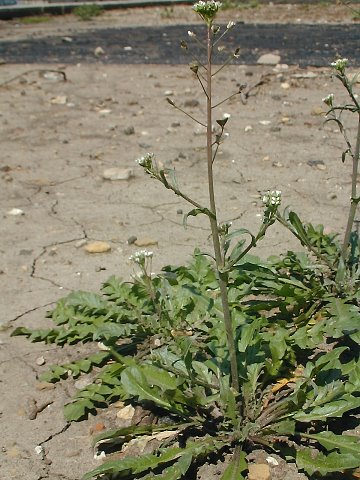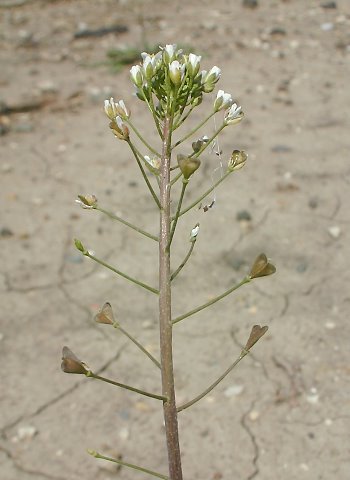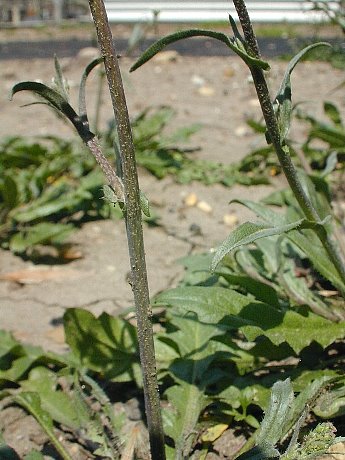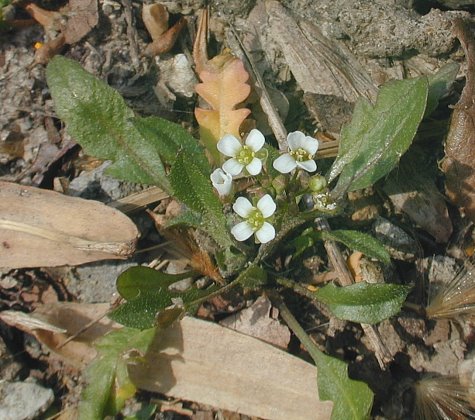Description: This plant is usually a winter annual, although sometimes it is a summer annual. It consists of a rosette of basal leaves up to 9" across, from which one or more flowering stalks develop that are little branched and up to 2½' tall (although individual plants can be much smaller than this). The basal leaves are up to 4½" long and ¾" across; they are elliptic, lanceolate, or oblanceolate, and pinnately lobed. The alternate leaves on the flowering stalks are much smaller in size and widely spaced; they are lanceolate, elliptic or linear in shape, and either smooth or slightly dentate along their margins. The bases of the alternate leaves are either sessile or they clasp their stalks with auriculate (ear-like) lobes. Both the basal and alternate leaves are medium to dark green and mostly hairless, although the lower sides of their central veins are often covered with appressed hairs. The terete stalks are light green to dark reddish purple (usually the latter), and they are usually glabrous above and appressed-hairy below.

Each stalk terminates in a raceme of small flowers. These flowers bloom only toward the tip of the raceme and they are short-lived. Each flower is a little less than 1/8" (3 mm.) across and consists of 4 white petals, 4 greenish sepals, a pistil with a single style, and several stamens. Plants that are winter annuals bloom during spring to mid-summer, while summer annuals bloom from mid-summer to fall. The flowers are replaced by seedpods that are obcordoid, somewhat compressed (flattened), and a little less than ¼" long. Each seedpod is divided into 2 cells and contains about 20 seeds. The slender pedicels of the seedpods are about ½-¾" long and ascending. The raceme elongates with maturity and can become up to 1½' long on large plants. The small seeds are yellowish to reddish brown, ovoid-oblongoid in shape, and shiny; they can remain viable in the ground for several years. The root system consists of a taproot. This plant spreads by reseeding itself.

Cultivation:
Shepherd's Purse is typically found in full sun, mesic to dry
conditions, and almost any kind of soil, including cracks in pavement.
The size of this plant varies considerably with the fertility of the
soil and availability of moisture. It is somewhat aggressive in
reseeding
itself.
Range & Habitat:
Shepherd's Purse is a common plant that occurs in every county of
Illinois (see Distribution
Map). It was introduced into North America from Europe.
Habitats include fields
and pastures, areas along railroads and roadsides, gardens and lawns,
construction sites, vacant lots, dirt paths, and waste ground. These
habitats can be either sandy or non-sandy. Shepherd's Purse is found in
highly disturbed areas, often where the soil surface has been exposed.

Faunal Associations: The nectar and pollen of the flowers attract mostly short-tongued bees and flies, including honeybees, Halictid bees, Andrenid bees, Syrphid flies, Tachinid flies, flesh flies (Sarcophagidae), and blow flies (Lucilia spp.). Less often, small butterflies and skippers suck nectar from the flowers (Robertson, 1929). The caterpillars of two butterflies, Anthocharis midea (Falcate Orangetip) and Pontia protodice (Checkered White), feed on Shepherd's Purse (Opler & Krizek, 1984). Other insect feeders include Entomoscelis americana (Red Turnip Beetle), several flea beetle species (Phyllotreta spp.), larvae of Liriomyza trifolii (American Serpentine Leafminer Fly), Holcostethus limbolarius (a stink bug), Myzus cerasi (Black Cherry Aphid), Lipaphis pseudobrassicae (False Cabbage Aphid), and Ceutorhynchus erysimi (a weevil); see Clark et al. (2004), Spencer & Steyskal (1986), Rider (2009), Blackman & Eastop (2013), and Majka et al. (2007). Information about this plant's relationships with vertebrate animals is more limited. White-tailed Deer browse on the leaves and flowering stalks: because the seeds of Shepherd's Purse can pass through the digestive tract of this animal and remain viable, they are spread to new areas (Myers et al., 2004). The Eastern Goldfinch sometimes eats the seeds, while the Prairie Vole (Microtus ochrogaster) feeds on the leaves of this plant to a limited extent (Martin et al., 1951/1961; Cook et al., 2004).

Photographic
Location:
A garden bed of an abandoned hotel in Urbana, Illinois, and an area
along a bike path on the campus of the University of Illinois in the
same city.
Comments:
Shepherd's Purse is an easy plant to identify among members of the
Mustard family because of the distinctive shape of its seedpods. This
shape apparently resembles the leather purse of shepherds during the
Middle Ages. The hairiness of the flowering stalks and the shape of the
leaves is rather variable across different populations of plants.
Sometimes the basal leaves are deeply lobed, while on other occasions
they are shallowly lobed.